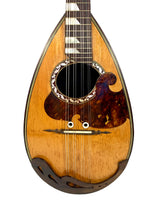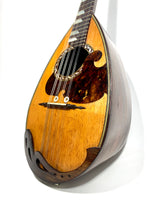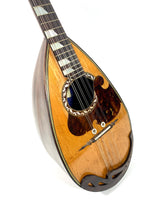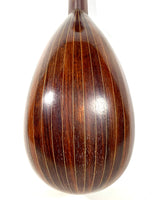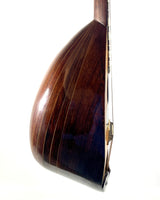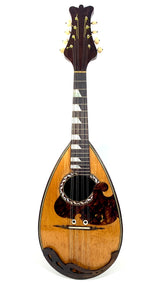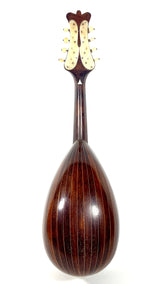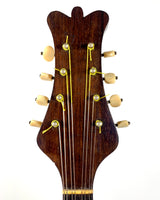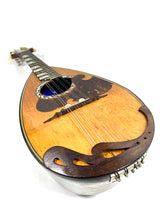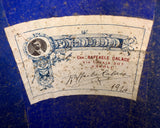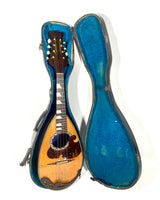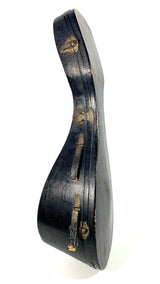Raffaele Calace
Mandolin by Raffaele Calace 21 bis from 1914
Raffaele Calace (1863-1934), composer, performer, teacher and luthier, is the most significant personality in the history of the mandolin. He revolutionized his violin making by transforming a ceremonial and accompaniment instrument into an instrument of virtuosity for the soloist, inventing new variations (the mandolyre, the cantabile lute) and simplifying his violin making to manufacture it, while establishing a company which still continues today.

Photo by Raffaele Calace.
(Source: www.alchetron.com)
The 21 bis model presented here is the rarest production model ever created by Calace (we only know of three other examples) and undoubtedly the most beautiful. A variation of the mandolyra aimed at the female audience, of which he takes over the lead, it is an orchestral instrument achieving the synthesis of art nouveau and art deco: decor both dynamic and fanciful, harmony of curved and geometric lines, sobriety of decorations. The fillets and the perfect almond body shape are particularly elegant.
In 1914, Raffaele Calace had not yet systematized the concert key and , in order not to harm the beauty of the instrument, he subtly moved downwards (following the model of Luigi Salsedo's instruments) the hearing allowing for play two more notes (19 frets compared to 17 previously). With a manufacturing cost similar to model No. 13 with a concert key, model 21bis was abandoned in favor of the first at the beginning of the 1920s.
This model was also one of the three presented in Jérôme Thibouville Lamy's catalog between 1909 and 1912, being the only importer of Raffaele Calace in France at this period.

Extract from Jérome Thibouville Lamy's catalog of 1912, page 111, mandolins by Raffaele Calace.
(Source: http://www.luthiers-mirecourt.com)
Like all our instruments, this one has been restored according to the rules of the art to be fully playable and found as close as possible to the original condition.
The restorations are as follows: the instrument (integral and in very good original condition) and its fittings have been completely cleaned, the table slot has been closed with a flipot and reinforced with cleats.
The left part of the arm rest which was missing has been restored in continuity with the existing one. The fingerboard has undergone planimetry and the mother-of-pearl inlays have been upgraded. The internal thread of the rosette was reconstructed over a centimeter and the missing triangle at the junction of the head and the handle was remade into bone from the exact trace it had left. And the two “twin holes ", missing, it was restored identically by two Calace pieces from the same period.
It is therefore a fully restored, functional and adjusted instrument with its original fittings (oiled tuners, bridge, tailpiece and arm rest), no additional costs are to be expected .
It is possible for you to upgrade this orchestral instrument into a solo instrument at a lower cost by extending the last frets to create a concert touch which would rest on the table. However, our philosophy is to return each instrument to a condition as close as possible to that on the day of its conception and to restore its original historical state as much as possible, so we do not carry out this type of transformation.
Technical characteristics :
- Top: Spruce (oiled)
- Back: Rosewood
- Neck: Rosewood veneer
- Fingerboard: Rosewood
- Width at nut: 27 mm
- Radius: Flat
- Frets: 19 frets
- Scale: 330 mm
- Profile: Neapolitan
- Pickguard: Tortoiseshell
- Country of manufacture: Italy, Naples
- Year: 1914
- Finish: Natural
- Decorations: Threading on the edge of the table and rosette / Rosette inlaid with complex patterns in white mother-of-pearl / Trapezoidal-shaped key markers in white mother-of-pearl
- Details: Normal signs of wear for its age / Delivered in its period case
Like all our instruments, this mandolin has been restored according to the rules of the art to be fully playable and returned to the condition as close as possible to that of the original.
This mandolin has a subtle and elegant sound, with singing highs typical of Calace. The depth of the body gives the mandolin a lot of roundness across the entire spectrum. It is an instrument that bears the aesthetic signature, both visual and musical, of its creator – Calace – with a typically Neapolitan softness and harmony . The mandolin comes assembled with Thomastik Präzision flat wound strings which further accentuate these qualities.
We guarantee that this mandoline is an authentic Raffaele Calace.

